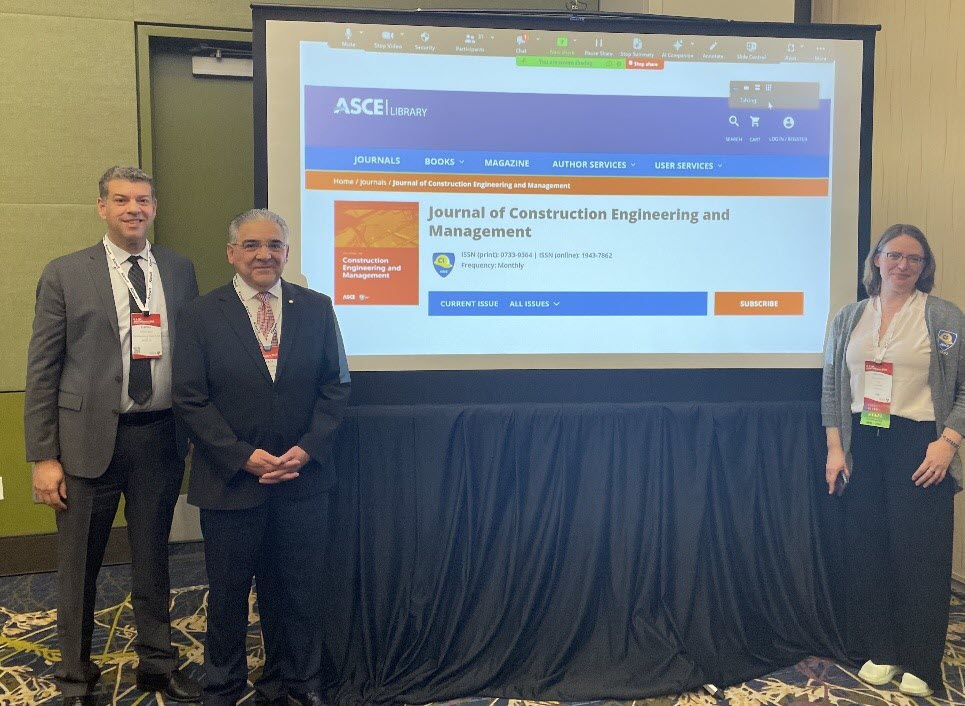
The Journal of Construction Engineering and Management is one of ASCE’s flagship publications. And as such, it’s earned its reputation as one of the leading sources for research-based engineering and technical information related to construction engineering and construction management.
This year marks a big change for the journal, though.
Longtime editor-in-chief Jesus M. de la Garza, Ph.D., Dist.M.ASCE (Clemson University), is stepping down this fall, handing the journal’s reins to longtime associate editor Carlos H. Caldas, Ph.D., P.E., M.ASCE (University of Texas at Austin).
Civil Engineering Source recently spoke to both about the journal and how they’re working together to ensure a smooth transition.
Civil Engineering Source: What are you most proud of as you look back on your time leading the journal?
Jesus M. de la Garza: There are four things that come to mind. Number one is that the quality and, very importantly, the journal’s impact has continued to increase significantly. The quality and impact are as strong as they have ever been.
Number two, the authorship base has continued to increase significantly, as evidenced by the number of papers we’ve published annually.
Then, number three: the peer review rigor is very much evidenced by the very selective acceptance rate that we have in the journal.
And finally – and this is as important as the other three things – the journal continues to be the prime knowledge dissemination outlet for the construction engineering and management community, as evidenced by the very large number of national and international submissions that we receive annually.
Source: So, Carlos, as you take the reins here, what do you hope the journal can contribute to the industry?
Carlos H. Caldas: I see the journal as one of the best mechanisms to communicate and disseminate the latest innovations to the industry.
Most companies in the construction industry are relatively small and don't have research-and-development departments. The journal plays a key role in disseminating what’s going on in different areas within construction engineering and management in a way that helps companies assimilate those innovations.
And that creates a good connection between the theory and the practice. It's not only the research presented in journal papers informing the industry but also the industry disseminating findings and providing feedback to academia. So, we have it both ways.
The theory and practice need to be connected, and our journal is an important way to strengthen this connection.
Source: When you hear Jesus’ list of accomplishments or qualities regarding the journal, are there certain elements you hope to prioritize and keep going under your watch? And are there some new ideas and approaches you want to bring?
Caldas: Jesus mentioned four main accomplishments, and I agree with all of them. We should continue this successful trajectory. We definitely want to continue that.
When you look at the components of the journal that that we would like to retain: one of course is the editorial board. It’s really one of the strengths of the journal with the team that Jesus put together; it helps to accomplish all of our goals.
We want to continue using the review process that Jesus put in place too – the workflow with very clear milestones and methods to track progress.
In terms of new ideas, the field of construction engineering and management is rapidly evolving. Things are changing quickly. The journal needs to continue to cover traditional topics but also expand its scope to include new topics – for instance, advances in information technologies, AI and machine learning, and how they are impacting our field; also looking at the issues related to environment, safety and governance. We also see the need to go beyond a project-level focus and look more at the impact on cities and society.
One other aspect that goes back to your question about how the journal can contribute to industry is marketing. I think we can do more in terms of making what’s being published in the journal more accessible to industry. It’s hard for people working for a company to access and read an academic paper. In the future, we can consider, maybe on an annual basis, having a summary of some of the key articles that were published that year, but written for an industry audience. I think this communication is important, again, strengthening that link between academia and industry.
Source: Jesus, can you describe the process of getting the journal ready to hand off to a new editor?
de la Garza: Absolutely. The process that we put in place with the help of the Construction Institute was a robust search process which led to this amazing outcome of Carlos Caldas as the next editor-in-chief. So we began a steadfast transition, because he will officially take over October 1.
Back in January, we started meeting every Friday to look at what papers are a problem, how do we solve the problems, our monthly reports, our quarterly reports, and how we report statistics back to the editorial board. I believe these weekly meetings have had the right effect, because Carlos is now comfortable with the process.
He may choose to change it and tweak it and enhance it. That's going to be his signature, but at least he will hit the ground running. We’re not going to miss a beat because we've been preparing very formally for the transition.
We’ve been very deliberate, and that’s how the Construction Institute wanted it to happen. And so, I believe very strongly that when October 1st comes around, nobody will see anything unusual out of the journal because Carlos will have been fully transitioned into his new role.
Source: I think it would be interesting to check back on October 2nd and see how Carlos is feeling then.
Caldas: Oh, I'm already feeling good today, so in October, I'm only going to be feeling better. [laughs]
de la Garza: [laughs] Yes, he’s going to be great.
ASCE is celebrating the 150 volumes of journal publications milestone in 2024. As one of the 15 flagship journals, the Journal of Construction Engineering and Management is among those to select a handful of articles from its archive to highlight the past, present, and future of civil engineering. They are available for free through Dec. 31.



